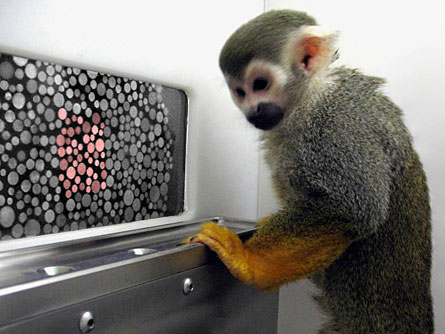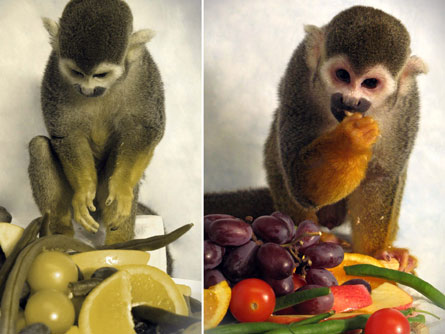Two monkeys see a more colorful world
A genetic experiment changes the way monkeys see the world
 |
|
A colorblind male squirrel monkey named Dalton is pictured here taking a color vision test.
|
| Neitz Laboratory, University of Washington |
For a pair of squirrel monkeys named Sam and Dalton, the world recently got more colorful. Male squirrel monkeys are normally red-green colorblind, which means they have trouble seeing those colors. But now, thanks to an experiment by scientists at the University of Seattle, Sam and Dalton see things differently—they seem to be able to see red and green.
Animals (including people) are able to see different colors of light thanks to proteins in the eye. Proteins are important building blocks of cells, and different kinds of proteins serve specific purposes in a living organism. When an important protein is absent or disabled, the animal cannot function properly. Male squirrel monkeys normally lack the proteins that detect red and green light, which means they can’t tell red and green from other colors. The monkeys can see blue and yellow.
Jay Neitz is the scientist at the University of Washington who led the research to give the monkeys more colorful vision. He says the experiment wasn’t supposed to work. In fact, when he asked other scientists who study vision if they thought color vision was possible in colorblind monkeys, “every single person said, ‘absolutely not,’” he says.
Neitz and his team were able to add genes that make proteins for detecting red light in the monkey’s eyes. A gene is like a recipe for building a protein, and different genes direct the body how to build different proteins. Almost every cell of a living organism contain DNA, or deoxyribonucleic acid, which is the set of instructions for how to make that organism function. These instructions include all the genes, which are segments of DNA.
A gene is also responsible for building the protein that enables an animal to see the color red. Neitz and his team found male squirrel monkeys that don’t have this gene—so for their experiment, they tried to give the gene to the monkeys.
They injected the monkeys with a virus that contained the gene. (Even though we usually think of viruses are harmful, scientists have found ways to use them in helpful ways—like to deliver genes to a monkey’s eye!) Over the next few weeks, the monkeys began to make the red-detecting protein. After about 20 weeks of this gene therapy, the monkeys were making enough of the protein to be able to tell red from green.
 |
|
Feasting time Digital simulations show what a squirrel monkey named Dalton may have seen before (left) and may now see after (right) gene therapy to correct his color blindness.
|
| Neitz Laboratory, University of Washington |
To test the monkeys’ eyesight, Neitz and his team showed them a grid of dots, some of them colored, some of them gray. If the monkeys pressed the colored dots, they received a treat—grape juice. Before the gene therapy, the monkeys could easily pick out blue or yellow dots, but they had a hard time telling red or green dots from gray dots or from each other. After receiving the gene injections, Sam and Dalton were able to pick out all of the colors (and drink lots of grape juice).
Bevil Conway, a neuroscientist at Wellesley College in Massachusetts, says the experiment shows that seeing in full color only requires the addition of a gene for detecting certain colors of light. Before the experiment, scientists were not sure whether the monkey’s brains would know how to handle new colors—but the monkeys seemed to be able to see and understand the new colors right away. “Somehow the brains of these monkeys are already wired to decode these color signals,” Conway says.
Neitz’s experiment is good for Sam and Dalton—but what about the rest of the world? They say it’s too early to know if genetic therapy could ever be used to help colorblind people see colors, or to help blind people see. Plus, it may be true that Sam and Dalton aren’t seeing red and green as we know them—they may just be seeing other shades of yellow and blue.
Nonetheless, the idea of giving color vision to a couple of monkeys is capturing the attention of researchers who study vision. “The achievement is technically amazing and conceptually very cool,” says Melissa Saenz, a scientist at Caltech in Pasadena, Calif.
POWER WORDS (adapted from the Yahoo! Kids Dictionary)
gene: A hereditary unit consisting of a sequence of DNA that occupies a specific location on a chromosome and determines a particular characteristic in an organism. Genes undergo mutation when their DNA sequence changes.
proteins: Molecules that contain carbon, hydrogen, oxygen, nitrogen, and usually sulfur and are composed of one or more chains of amino acids. Proteins are fundamental components of all living cells and include many substances that are necessary for the proper functioning of an organism.
cell: The smallest structural unit of an organism that is capable of independent functioning. It consists of one or more nuclei, cytoplasm, and various organelles, all surrounded by a cell membrane.
virus: Any of various simple submicroscopic parasites of plants, animals, and bacteria that often cause disease and that consist essentially of a core of RNA or DNA surrounded by a protein coat.
:colorblind: Partially or totally unable to distinguish certain colors
DNA: A nucleic acid that carries the genetic information in the cell and is capable of self-replication and synthesis of RNA. DNA consists of two long chains of nucleotides twisted into a double helix and joined by hydrogen bonds
Going Deeper:







